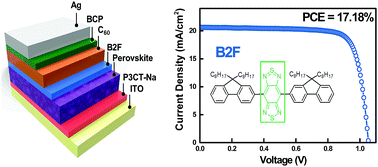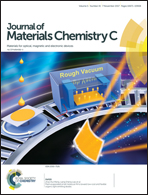A benzobis(thiadiazole)-based small molecule as a solution-processing electron extraction material in planar perovskite solar cells†
Abstract
A novel small-molecule, B2F, which is based on benzobis(thiadiazole), was designed and synthesized as an electron extraction material for perovskite solar cells (PSCs). Because of the high electron affinity of the benzobis(thiadiazole) unit and the Pb–S bonding, B2F exhibited good adhesion on the perovskite surface and an efficient photoluminescence quenching to CH3NH3PbI3. The simple device with B2F as the solution-processing electron extraction layer without any extra interface layer exhibited an optimal power-conversion efficiency (PCE) of 12.35%. The B2F-based device can be further improved by the addition of C60/BCP as efficient electron transport and hole-blocking layers to enhance electron transport and prevent carrier leakage. A champion PCE of 17.18% was achieved with an open-circuit voltage of 1.052 V, a short-circuit current density of 20.63 mA cm−2 and a fill factor of 79.15%. In summary, we developed an efficient electron extraction material for PSCs, which represents a new building block for the design and development of highly efficient electron transport materials for PSCs in the future.



 Please wait while we load your content...
Please wait while we load your content...